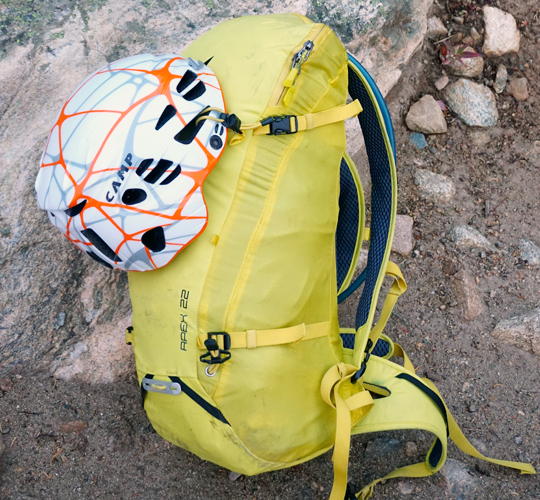[Photo] Andrew Councell
MSRP: $120
Maybe Jerry Seinfeld said it best in one of his stand-up bits when he said that the helmet is designed “to preserve a brain whose judgment is so poor, it does not even try to avoid the cracking of the head it’s in.” As climbers and skiers, we embrace some risks while seeking to minimize others, and wearing a helmet seems like the obvious way to continue doing both. The other option would be to simply stop doing these activities but there’s no fun in that even if Jerry makes fun of them. Fortunately, CAMP designed their Speed 2.0 helmet to preserve our brains in multi-functional and fashionable ways.
The Speed 2.0 is lightweight (268g), and it is designed to function for both climbing and skiing. Its in-mold Styrofoam construction keeps it light and the 2.0 represents an upgrade from its predecessor with a polycarbonate external shell that increases its durability. The padding is ample and comfy without being too smarmy on hot days, aided by lots (22) of vent holes. The helmet has clips on the front and rear to secure a headlamp.
While the original Speed was lighter, there were issues with durability because the Styrofoam was exposed. My Speed 2.0 has been squeezed through chossy desert chimneys, dragged around alpine country in the USA and Canada, repeatedly stuffed tightly into packs and has deflected falling ice chunks on dozens of ice routes. All the while it showed few signs of visible use, let alone any damage. CAMP advertises their Speed 2.0 as “one of the lightest helmets in the world,” but Black Diamond’s Vapor helmet is 68g lighter and Petzl’s Sirocco is over 100g lighter. That said, while perhaps not being the lightest, CAMP’s lid strikes a balance between durability and weight without being too bare bones for such an important piece of safety equipment.
The spin-dial for adjusting the fit is easily manipulated with gloved hands, and, unlike some older helmets on the market, the dial holds the headband sets firmly where I set them. (Older BD helmets utilized a spin-dial adjuster that never held in place for me. Their current models use a ladder system which is much better.) However, the helmet doesn’t fit my head–it’s too round–and the helmet only comes in one size. Other helmet brands, including Black Diamond and Petzl, are more oblong, which fit my head better. Even when wearing a toque or my usual Buff headband, the fit remains the same: certainly comfortable but just wider than other brands.
As the line between alpine climbing and skiing becomes increasingly fuzzy, the Speed 2.0 becomes increasingly attractive. As a pure climbing helmet there are better options out there. I find this one just sits on the top of my head rather than encompassing it. While the Speed 2.0 gets an EN12492 certification (mountaineering), it doesn’t pass the EN1077 certification (skiing) because of its many vent holes (Mammut’s Alpine Rider helmet passes both ski and mountaineering certifications but weighs 430g). For this reason, I don’t use the Speed 2.0 for operational heli-skiing work; instead I wear a designated ski helmet. However, for ski touring and ski mountaineering, I take the Speed 2.0 because it’s lightweight and offers protection for whatever falls off a mountain (ice, rocks, snow chunks). A few of us used this helmet on a recent AMGA Advanced Ski Guides Course in the Whistler area for these reasons.

[Photo] Andrew Councell
The helmet I tested is white with orange graphics (it also comes in green with orange graphics and orange with green graphics), reflects solar heat, and keeps my brain cool when stressful situations demand quick decisions. This makes me think that Seinfeld was right–I’m just too dumb to stop these sports.
Pros: Light and durable; well ventilated. A great multi-sport helmet.
Cons: Round shape doesn’t fit my oblong-shaped head; sits on top of the head instead of around it.